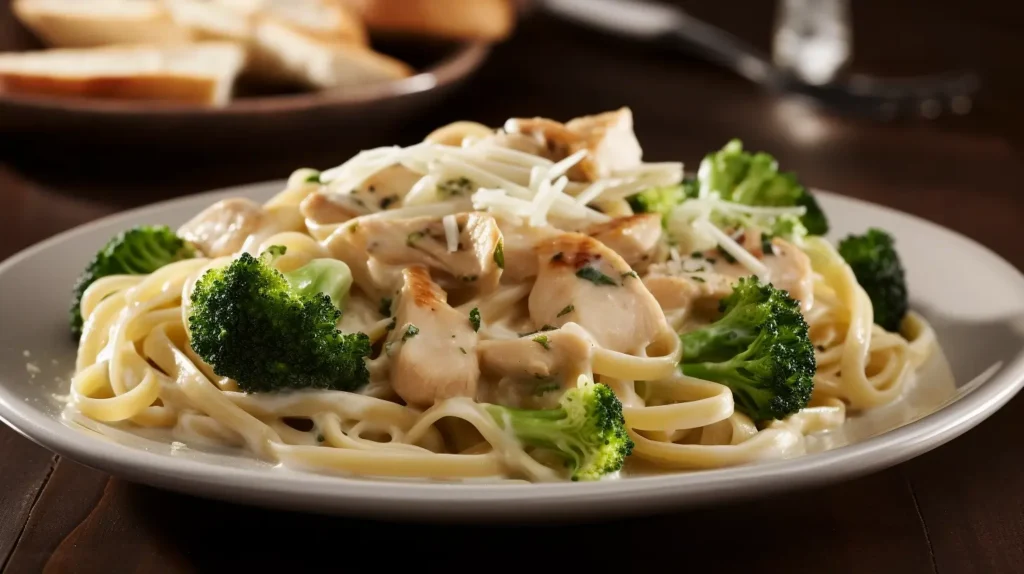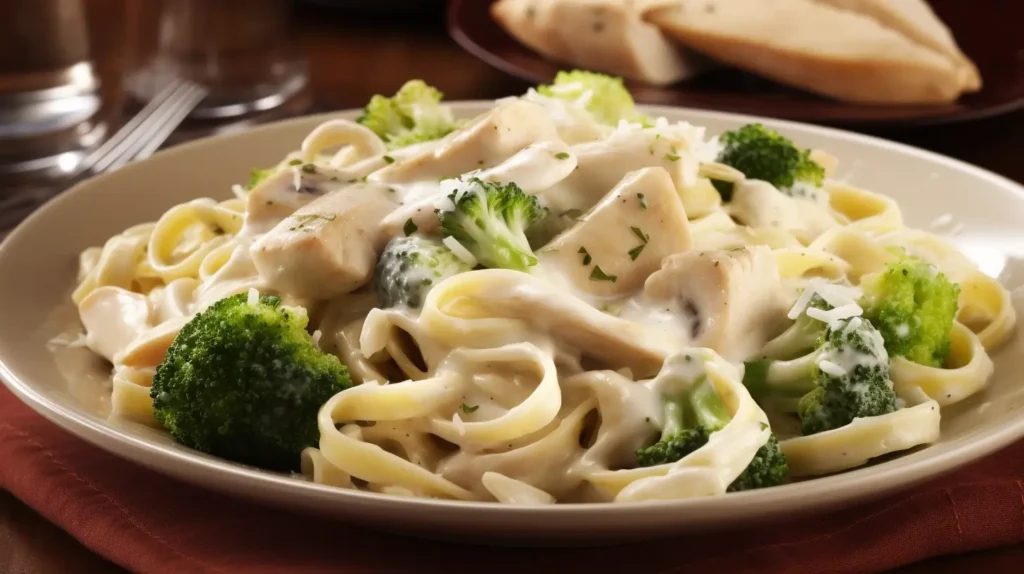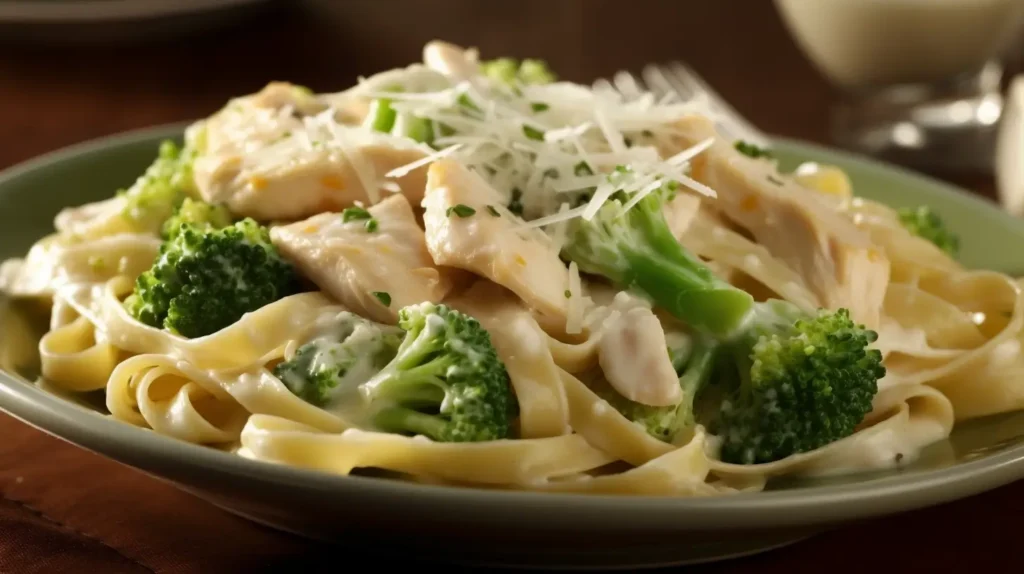Table of Contents
Chicken and Broccoli Fettuccine Alfredo: A Creamy, Comforting Meal

Chicken and Broccoli Fettuccine Alfredo combines tender chicken, fresh broccoli, and creamy Alfredo sauce with perfectly cooked fettuccine. This Italian-American classic is a favorite for its rich flavors, ease of preparation, and balance of protein, vegetables, and pasta.
If you’re looking to perfect your Alfredo sauce, check out how to make Alfredo sauce for tips on creating a creamy and flavorful base. Pairing a great sauce with the right pasta ensures a dish that’s both delicious and satisfying.
What Makes Chicken and Broccoli Fettuccine Alfredo Special?
Chicken and Broccoli Fettuccine Alfredo combines three main components that make it stand out:
- Fettuccine Pasta: Wide, flat noodles ideal for creamy sauces.
- Alfredo Sauce: A luscious blend of butter, garlic, cream, and Parmesan.
- Chicken and Broccoli: Protein-packed chicken and fresh broccoli balance the richness of the sauce.
This dish is not only delicious but versatile, allowing for substitutions to suit dietary needs or preferences. For a variation, you can try the Chicken Tortelloni Alfredo from Olive Garden for a similar creamy pasta dish.
Ingredients You’ll Need
Here’s a breakdown of the key ingredients for this creamy pasta dish:
- Chicken: Boneless, skinless breasts or thighs, cooked until golden.
- Broccoli: Use fresh or frozen florets for a bright, healthy addition.
- Fettuccine Pasta: The classic choice for Alfredo, but any pasta will do.
- Butter and Garlic: Essential for flavoring the Alfredo sauce.
- Heavy Cream: Provides a creamy base.
- Parmesan Cheese: Adds depth and richness.
- Olive Oil, Salt, and Pepper: For seasoning and cooking.
How to Make Chicken and Broccoli Fettuccine Alfredo
1. Cook the Chicken
- Heat olive oil in a skillet over medium heat.
- Cube the chicken, season with salt and pepper, and cook until golden brown and fully cooked (about 5-7 minutes). Remove from the skillet and set aside.
2. Prepare the Broccoli
- Steam fresh broccoli or sauté it in the same skillet used for the chicken. If using frozen broccoli, thaw and drain excess water before cooking.
3. Cook the Fettuccine
- Boil the fettuccine in salted water until al dente. Reserve 1 cup of pasta water before draining.
4. Make the Alfredo Sauce
- In the skillet, melt butter and sauté minced garlic until fragrant.
- Stir in heavy cream and Parmesan cheese, whisking until the sauce is smooth. Add reserved pasta water to adjust the consistency if needed.
5. Combine and Serve
- Toss the fettuccine in the sauce, then fold in the cooked chicken and broccoli. Garnish with extra Parmesan and serve warm.
Choosing the Right Chicken for Fettuccine Alfredo
Breast vs. Thighs: What Works Best?
When preparing Chicken and Broccoli Fettuccine Alfredo, selecting the right chicken cut is essential for flavor and texture. Boneless, skinless chicken breasts are lean and cook quickly, making them an excellent choice for this dish. However, if you prefer a richer taste, boneless chicken thighs offer more juiciness and flavor.
Tips for Perfectly Cooked Chicken
Season the chicken with salt, pepper, and garlic powder before cooking. Searing in a hot skillet with olive oil ensures a golden crust and locks in the juices. To achieve even cooking, use chicken pieces of similar size and thickness. Let the chicken rest for a few minutes after cooking to retain its moisture and make slicing easier. Well-prepared chicken creates a balanced base for the creamy Alfredo sauce and complements the fresh broccoli beautifully.
Broccoli Preparation for Maximum Flavor
Fresh vs. Frozen: Which Is Better?
Both fresh and frozen broccoli work well in this dish. Fresh broccoli offers a vibrant flavor and crunch, while frozen broccoli provides convenience. If using frozen, thaw it beforehand and drain excess water to prevent the dish from becoming watery.
How to Cook Broccoli for Alfredo Dishes
Steam fresh broccoli until tender but still firm, or sauté it with garlic for added depth of flavor. If you prefer roasted broccoli, lightly coat florets with olive oil and roast in the oven for a caramelized finish. Broccoli adds a fresh, healthy element that balances the creaminess of the Alfredo sauce and pairs wonderfully with chicken and pasta.
The Art of Making Creamy Alfredo Sauce
Why Homemade Sauce Is Best
Homemade Alfredo sauce provides a fresher and more authentic flavor compared to store-bought alternatives. It allows you to control the ingredients, creating a rich and creamy texture without unnecessary additives.
Steps for Perfect Alfredo Sauce
Start by melting butter in a skillet and sautéing minced garlic until fragrant. Add heavy cream and whisk continuously over low heat. Slowly incorporate freshly grated Parmesan cheese, stirring until the sauce is smooth and thickened. Adjust the consistency by adding reserved pasta water, and season with salt and pepper to taste. The sauce’s creamy richness ties the dish together, making every bite irresistible.
Cooking Fettuccine to Perfection

Choosing Quality Pasta
Selecting high-quality fettuccine is crucial for achieving the best results. Look for pasta made from durum wheat for a firm texture and superior taste.
Tips for Cooking Fettuccine
Cook fettuccine in a large pot of salted, boiling water until al dente. The pasta should be firm enough to hold its shape but tender enough to absorb the Alfredo sauce. Reserve a cup of pasta water before draining, as it can help adjust the sauce’s consistency. Properly cooked fettuccine ensures the creamy sauce clings to every strand, creating a harmonious balance of flavors.
Adding More Vegetables to the Dish
Vegetable Options That Pair Well
In addition to broccoli, consider adding mushrooms, spinach, or bell peppers to your Chicken and Broccoli Fettuccine Alfredo. These vegetables add texture, color, and flavor diversity to the dish.
Preparing Vegetables for Maximum Flavor
Sauté mushrooms in olive oil until golden, or blanch spinach for a tender, vibrant addition. Roasted bell peppers provide a smoky sweetness that complements the creamy Alfredo sauce. Including a variety of vegetables not only enhances the dish’s nutritional value but also creates a visually appealing presentation.
Perfecting the Texture of Chicken and Broccoli Fettuccine Alfredo
Balancing Creaminess in the Alfredo Sauce
The texture of the Alfredo sauce is a defining feature of Chicken and Broccoli Fettuccine Alfredo. Achieving the right balance between creamy and smoothness involves using fresh ingredients and precise techniques. Start by melting butter over low heat and sautéing minced garlic until fragrant. Gradually add heavy cream while whisking to avoid lumps. Incorporating freshly grated Parmesan cheese in small batches ensures a silky finish.
If the sauce feels too thick, thin it with reserved pasta water. For a thicker consistency, simmer the sauce for a few extra minutes to reduce it. Adjust seasoning to balance the creaminess with subtle savory notes.
Maintaining Pasta Texture
Cooking fettuccine to al dente is equally important for texture. Boil the pasta in salted water and drain just before it becomes too soft. Toss it in the sauce immediately to coat each strand. Properly cooked pasta holds its shape and creates a harmonious bite when paired with tender chicken, crisp broccoli, and velvety Alfredo sauce. Attention to texture elevates the dish from good to exceptional, making every bite satisfying.
Customizing for Special Diets
Low-Carb and Gluten-Free Options
For those following a low-carb or gluten-free diet, replace fettuccine with zucchini noodles, spaghetti squash, or gluten-free pasta. These alternatives provide a lighter option while retaining the essence of the dish.
Dairy-Free Alfredo Sauce
To make a dairy-free version, substitute butter with vegan butter, cream with coconut milk or cashew cream, and Parmesan with nutritional yeast. These substitutions maintain a creamy texture and rich flavor, making the dish accessible to those with dietary restrictions.
Perfect Pairings for a Complete Meal
Side Dishes to Serve with Alfredo
Chicken and Broccoli Fettuccine Alfredo pairs wonderfully with side dishes like garlic bread, roasted asparagus, or a crisp Caesar salad. These options balance the meal by adding contrasting textures and flavors.
Refreshing Beverages
Serve with sparkling water infused with lemon or a chilled herbal tea for a refreshing complement. These beverages cleanse the palate and highlight the creamy richness of the dish. Pairing thoughtful sides and drinks with this pasta dish creates a well-rounded dining experience.
Serving Suggestions
Enhance your meal with these sides:
- Garlic Bread: Perfect for soaking up the sauce.
- Caesar Salad: Adds a crisp, refreshing contrast.
Storing and Reheating
- Refrigeration: Store leftovers in an airtight container for up to 5 days.
- Reheating: Warm in a skillet with a splash of water or cream to restore the sauce’s texture. Avoid microwaving, as it may dry out the dish.
- Freezing: Freeze for up to 6 months. Thaw overnight in the fridge before reheating.
Recipe Variations
Customize your Chicken and Broccoli Fettuccine Alfredo with these ideas:
- Proteins: Swap chicken for shrimp, salmon, or tofu.
- Vegetables: Add mushrooms, spinach, or bell peppers for extra flavor.
- Low-Carb Option: Replace fettuccine with zucchini noodles or shirataki noodles.
Cooking in One Pan for Easy Cleanup
Why One-Pan Cooking Works
Cooking Chicken and Broccoli Fettuccine Alfredo in a single pan saves time and minimizes cleanup. Sear the chicken, steam the broccoli, and prepare the Alfredo sauce in the same pan before tossing in the pasta.
Step-by-Step Process
Start with the chicken, then use the same pan to cook broccoli, allowing the flavors to blend. Once the sauce is prepared, combine everything for a quick, mess-free meal. One-pan cooking simplifies preparation without compromising taste.

FAQs:
What pasta works best for Alfredo sauce?
While fettuccine is traditional, linguine, penne, or rigatoni also pair well with creamy sauces.
Can I make this dish dairy-free?
Yes, substitute the butter, cream, and Parmesan with dairy-free alternatives like vegan butter and cashew cream.
Can I use frozen broccoli?
Absolutely. Thaw and drain it before adding to the dish to avoid excess moisture.
How do I thicken Alfredo sauce?
Reduce it on the stovetop or stir in a small amount of cornstarch slurry for quick thickening.
What’s the best way to reheat this dish?
Reheat in a skillet over low heat with a splash of cream or water to maintain the sauce’s consistency.
Can I Substitute Broccoli with Other Vegetables?
Yes, you can use vegetables like asparagus, green beans, or peas as substitutes. These options provide a fresh and vibrant contrast to the creamy Alfredo sauce while maintaining the dish’s balance.
How Do I Prevent Alfredo Sauce from Becoming Greasy?
Cook the sauce over low heat and whisk continuously while adding Parmesan. Avoid overheating, as high temperatures can cause the fat in the cream and cheese to separate, leading to a greasy texture.
Can I Make This Dish Ahead of Time?
Yes, you can prepare the chicken and broccoli in advance and refrigerate them. Cook the pasta and Alfredo sauce fresh to maintain their texture and flavor. Combine all ingredients before serving.
What Are the Best Herbs to Use in Alfredo Sauce?
Fresh parsley, basil, or thyme work well in Alfredo sauce. These herbs add a subtle, aromatic flavor that complements the creamy base and enhances the overall dish.
How Do I Keep Fettuccine From Sticking Together?
Cook fettuccine in a large pot of boiling, salted water. Stir frequently during the first few minutes of cooking and toss with a small amount of olive oil after draining.
Can I Add Cheese Other Than Parmesan?
Yes, Asiago, Pecorino Romano, or Gruyere can be used in place of Parmesan. These cheeses offer different flavor profiles while maintaining the creamy, cheesy texture of Alfredo sauce.
How Do I Store Leftover Alfredo Sauce?
Store leftover sauce in an airtight container in the refrigerator for up to 3 days. Reheat gently over low heat, adding a splash of milk or cream to restore its smooth, creamy consistency.
Can I Make This Dish Spicy?
Yes, you can add spice by including red pepper flakes or a dash of cayenne pepper to the Alfredo sauce. Adjust the amount based on your heat preference, tasting as you go to ensure the flavors remain balanced.
Conclusion
Chicken and Broccoli Fettuccine Alfredo is the perfect blend of creamy, savory, and fresh flavors. With this easy-to-follow recipe, you can bring restaurant-quality pasta to your home kitchen. Serve it for family dinners, date nights, or any time you crave a comforting, satisfying meal!